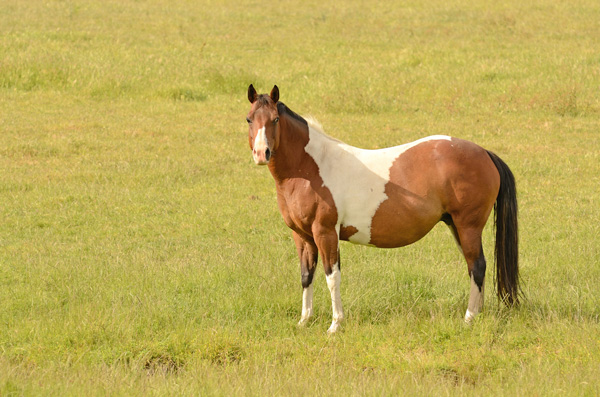
In this article by Ernie Martinez II, DVM, of Hagyard Equine Medical Institute near Lexington, Kentucky, we will learn about dental problems that young and growing horses can face.
The oral cavity of a young, growing horse is undergoing constant change. Unlike humans, horses have hypsodont teeth that are constantly erupting. Because of those constant changes, it is important to have a veterinarian dentist regularly examine the youngster’s oral cavity to avoid small problems becoming big problems.
From the time a foal is born to the time the horse is an adult, the number of teeth increases from 0-6 teeth in a foal to 36-44 in an adult. The average horse has a full mouth of 36-44 teeth (four rows of 11) by the age of four years.
During the first four years, it is important for a veterinary dentist to routinely evaluate the oral cavity for congenital and developmental disorders. If congenital and developmental disorders are not identified and addressed early, they may lead to more severe acquired disorders.
A newborn foal is born with few teeth. The first incisors may be present at birth or can be just below the gingival surface. The first incisors typically erupt through the gingiva around 6-8 days of life. All of the incisors should be present by 6- 9 months of age. The same is true for the 2nd, 3rd and 4th pre-molars. They may be present at birth, but they are generally exposed by two weeks of age. Three permanent molars erupt caudal (behind) to the premolars at 1, 2 and 3.5-4 years, respectively.
Congenital dental disorders can be diagnosed at birth or within the first few weeks as the deciduous teeth begin to erupt. Common congenital disorders include overjet, overbite, underjet, and wry nose.
Overjet to some degree is normal in most horses. In this case the front (rostral) edge of the upper incisor is farther forward than the front (rostral) edge of the lower incisor. A severe case of overjet can become an overbite where the entire upper incisor sits farther forward than the lower incisor. This is commonly called “parrot mouth.” An overbite rarely causes problems with biting and chewing (prehension and mastication) of food.
Normal incisors wear down due to contact with the opposite tooth during chewing. Special care may be needed during dental examinations to maintain proper incisor balance due to unopposed apposition of some or all of the incisors.
Wry nose is forward (rostral) deviation of the maxilla and the associated nasal septal deviation. It can result in disturbances to nasal airflow and uneven eruption of the incisors and cheek teeth. Mild cases may correct on their own, but severe cases could require surgical intervention. These cases require frequent dental care to balance incisor and cheek teeth overgrowth; and while the treatments are temporary, these conditions are permanent.
Developmental dental disorders can involve the deciduous teeth or the permanent teeth. Disorders include abnormal development, abnormal positioning, extra or supernumerary teeth, and lack of teeth or hypodontia.
Abnormal development or dental dysplasia may result in abnormally shaped teeth that do not fit properly with the incisor or cheek teeth row. This can cause uneven wear, disturbed eruption and periodontal disease from food packing.
Other abnormal dental developments can include defects of enamel formation resulting in abnormally shaped teeth. The causes of dental dysplasias can include genetics, in utero treatments, systemic diseases in the neonate, and trauma to the oral cavity and surrounding structures.
Developmental dysplasias can be identified with routine oral examinations and radiographic evaluations. Supernumerary teeth, or extra teeth, most commonly develop at the edges of the teeth margins. For example, these might appear at the outside of the upper and lower incisor rows and at the beginning or end of the cheek teeth row. They can occur in line with normal teeth or can be found on the lingual or buccal aspects of the normal cheek teeth row. Supernumerary teeth may arise from excessive tooth development (odontogenic capacity) or from the splitting of a tooth bud.
Supernumerary incisors are usually normal teeth and typically appear during permanent tooth eruption. For this reason they are often confused with retained deciduous caps and radiographs may be needed to differentiate the two. Supernumerary incisors can result in over crowding, displacement of normal teeth and uneven wear. They can usually be managed with routine reduction twice a year. Supernumerary cheek teeth most commonly develop at the caudal aspect of the maxillary cheek teeth rows (the back of the upper rows). But, they can also occur medially, laterally or rostrally to the upper and lower cheek teeth rows.
Supernumerary cheek teeth are commonly seen as the normal permanent cheek teeth are erupting. Their abnormal positions result in large interdental spaces, feed packing and painful periodontal disease. The teeth will most likely erupt unopposed causing a space to form (diastema) between that tooth and adjacent teeth. Oral extraction is the preferable option, if possible. If this is not possible, the crown is reduced to prevent soft tissue trauma and the diastema is widened to prevent food packing and periodontal disease. This can be difficult in the back of the mouth.
Caudal supernumerary teeth should be carefully evaluated with intra-oral tools and radiography to determine their effect on adjacent teeth and nearby sinuses.
Hypodontia, or reduced tooth numbers, is a developmental abnormality of equine teeth. It is fairly uncommon in horses and is most commonly caused by trauma, disease or excessive wear. The condition usually affects the permanent teeth and the main concern is balance or reduction of the opposite tooth as it erupts unopposed.
So as you can see, there are many problems that can occur in the mouths of young, growing horses. Therefore make sure your veterinary dentist regularly examines your youngsters’ mouths.


